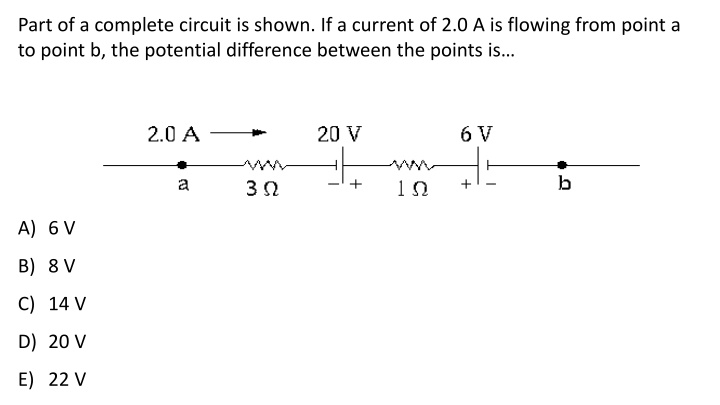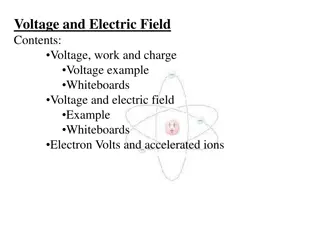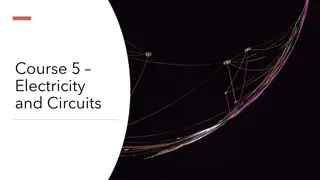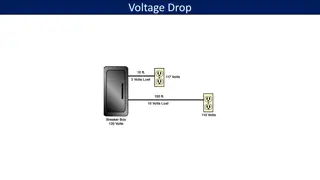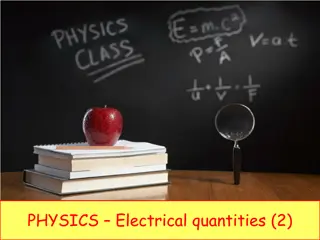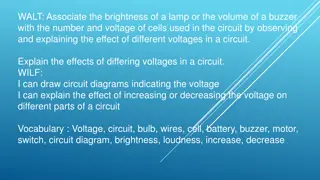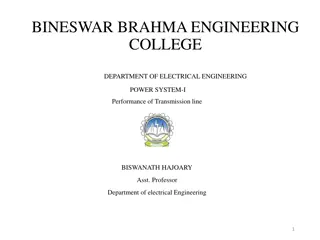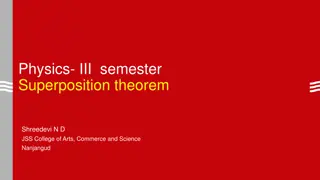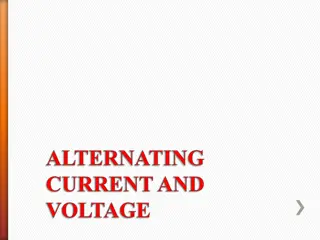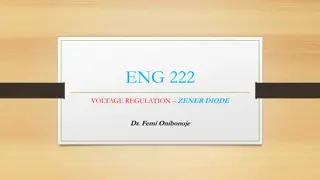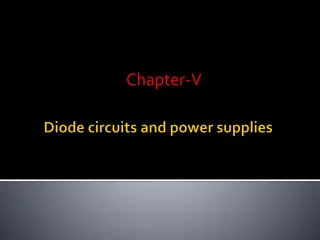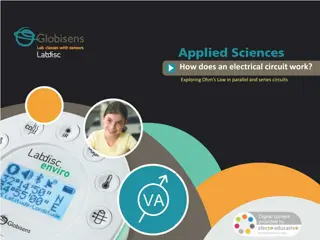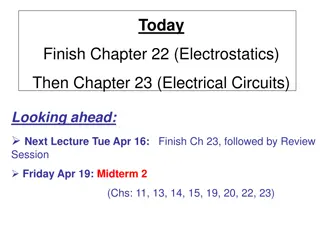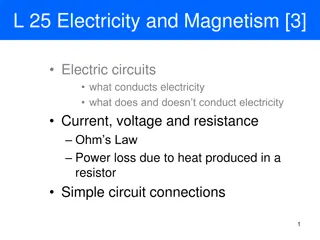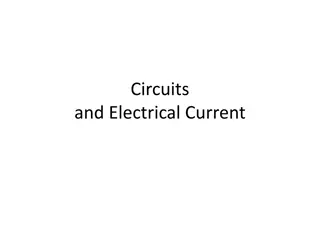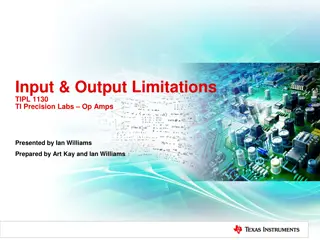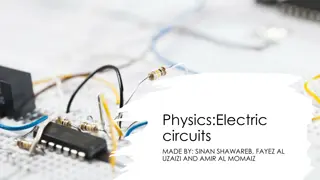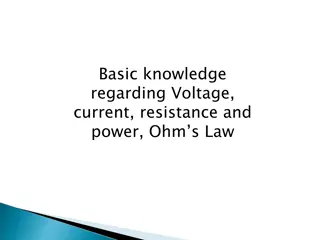Electrical Circuits: Understanding Voltage and Current
An overview of electrical circuits, including potential difference, current flow, voltage equations, and placement of measuring devices in circuits. Explore scenarios with images to test your knowledge of circuit principles.
Download Presentation

Please find below an Image/Link to download the presentation.
The content on the website is provided AS IS for your information and personal use only. It may not be sold, licensed, or shared on other websites without obtaining consent from the author.If you encounter any issues during the download, it is possible that the publisher has removed the file from their server.
You are allowed to download the files provided on this website for personal or commercial use, subject to the condition that they are used lawfully. All files are the property of their respective owners.
The content on the website is provided AS IS for your information and personal use only. It may not be sold, licensed, or shared on other websites without obtaining consent from the author.
E N D
Presentation Transcript
Part of a complete circuit is shown. If a current of 2.0 A is flowing from point a to point b, the potential difference between the points is A) 6 V B) 8 V C) 14 V D) 20 V E) 22 V
Part of a complete circuit is shown. If a current of 2.0 A is flowing from point a to point b, the magnitude of the potential difference between points a and b is A) 8 V B) 12 V C) 15 V D) 20 V E) 31 V
A circuit with two batteries is shown below. The directions of the currents have been chosen (guessed) as shown. Which is the correct current equation for this circuit? I1 R1 V1 R2 V2 I2 Loop 1 R3 I3 A) ?2= ?1+ ?3 B) ?1= ?2+ ?3 C) ?3= ?1+ ?2 D) none of these
What is the correct voltage equation for Loop 1? I1 R1 V1 R2 V2 I2 Loop 1 R3 I3 A) ?2+ ?1?1 ?2?2= 0 B) ?2+ ?1?1 ?2?2= 0 C) ?2+ ?1?1+ ?2?2= 0 D) ?2+ ?1?1+ ?2?2= 0 E) none of these
The switch in the circuit below is open. What is the magnitude of the voltage across the open switch? That is, what is ?? ??? A) 0 B) ? C) ? 2 D) ? 3 E) None of these
A flashlight requires 2 AA (1.5V) batteries, and is arranged as shown. Notice that the switch is open. Which statement is true.? + AA 1.5 V + AA 1.5 V - 0 - 0 A) The bulb has ? = 1.5 V across it, and glows B) The bulb has ? = 1.5 V across it, and is dark C) The bulb has ? = 3 V across it, and is dark D) The bulb has ? = 0 V across it, and is dark E) The bulb has ? = 0 V across it, and glows
If you wanted to measure the current through the battery, where in the circuit would you place an ammeter? A) (A) B) (B) C) (C) D) (D) E) None of these will work
If you wanted to measure the voltage across ?3, where in the circuit would you place a voltmeter? A) (A) B) (B) C) (C) D) (D) E) None of these will work
What does the ammeter read? 6 V A 2W A) 6 A B) 3 A C) 2 A D) 0 A E) The ammeter will break
Each of the resistors is 10 . Notice that the voltmeter has been placed incorrectly! What does the voltmeter read? A) 30 V B) 15 V C) 10 V D) 0 V
The switch S is initially at position a for a long time. It is then switched to position b . Describe what happens to the light bulb as a function of time after the switch is flipped from a to b . A) The light bulb goes on but goes off immediately. B) The light bulb goes off and stays off. C) The light bulb goes on but its brightness decreases with time and eventually goes off. D) The light bulb goes on and stays on at a constant brightness. E) The light bulb goes on but its brightness increases with time.
In the circuit shown below, the switch is initially closed (and has been closed for a long time) and the bulb glows brightly. When the switch is opened, what happens to the brightness of the bulb? A) The brightness of the bulb is not affected. B) The bulb gets dimmer. C) The bulb gets brighter. D) The bulb initially brightens, then dims. E) The bulb initially dims, then brightens.
A capacitor in an RC circuit is initially charged up to a voltage of 10 V and is then discharged through an ? = 10 resistor as shown. The switch is closed at time ? = 0. What is the current through the resistor, immediately after the switch is closed, at time ? = 0 + ?? 0.01 F I 10 V0 = 10V A) 1 A B) 0.5 A 1 ? A = 0.37 A C) D) None of these
A capacitor in an RC circuit is initially charged up to a voltage of 10 V and is then discharged through an ? = 10 resistor as shown. The switch is closed at time ? = 0. What is the current through the resistor, a long time after the switch is closed, at time ? = ? 0.01 F I 10 V0 = 10V A) 1 A B) 0.5 A 1 ? A = 0.37 A C) D) None of these
A capacitor in an RC circuit is initially charged up to a voltage of 10 V and is then discharged through an ? = 10 resistor as shown. The switch is closed at time ? = 0. What is the time constant for this circuit?? 0.01 F I 10 V0 = 10V A) 0.01 s B) 0.1 s C) 1 s D) 10 s E) None of these
A capacitor in an RC circuit is initially charged up to a voltage of 10 V and is then discharged through an ? = 10 resistor as shown. The switch is closed at time ? = 0. What is the current through the resistor at time ? = 0.2 s? 0.01 F I 10 V0 = 10V A) 1 A B) 0.5 A 1 ? A = 0.37 A C) D) None of these
The following circuits contain capacitors that are charged to 5.0 V. All of the switches are closed at the same time. After 1 second has passed, which capacitor is charged to the highest voltage? A) A B) B C) C D) D
An RC circuit is shown below. Initially the switch is open and the capacitor has no charge. At time ? = 0, the switch is closed. What is the voltage across the capacitor immediately after the switch is closed (time ? = 0 + ?)? R = 10 V = 10V C = 0.0010 F R = 10 A) Zero B) 10 V C) 5 V D) none of these
What is the voltage across the resistor on the far right at time ? = 0 + ?? R = 10 V = 10V C = 0.0010 F R = 10 A) Zero B) 10 V C) 5 V D) none of these
What is the initial current through the capacitor at time ? = 0 + ?? R = 10 V = 10V C = 0.0010 F R = 10 A) 1 A B) Zero C) 0.5 A D) none of these
A long time after the switch has been closed, what is the voltage across the capacitor? R = 10 V = 10V C = 0.0010 F R = 10 A) 5 V B) 10 V C) Zero D) none of these
Suppose both switches are closed. What is the voltage across the capacitor after a very long time? A) V B) V/2 C) V/3 D) 2V/3 E) zero
